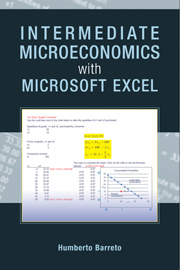Book contents
- Frontmatter
- Contents
- Preface
- User Guide
- Introduction
- PART I THE THEORY OF CONSUMER BEHAVIOR
- PART II THE THEORY OF THE FIRM
- 2.1 Production Function
- 2.2 Input Cost Minimization
- 2.3 Output Profit Maximization
- 2.4 Input Profit Maximization
- 2.5 Consistency in the Theory of the Firm
- 2.6 Monopoly
- 2.7 Game Theory
- PART III THE MARKET SYSTEM
- Conclusion
- Index
2.4 - Input Profit Maximization
from PART II - THE THEORY OF THE FIRM
Published online by Cambridge University Press: 05 June 2012
- Frontmatter
- Contents
- Preface
- User Guide
- Introduction
- PART I THE THEORY OF CONSUMER BEHAVIOR
- PART II THE THEORY OF THE FIRM
- 2.1 Production Function
- 2.2 Input Cost Minimization
- 2.3 Output Profit Maximization
- 2.4 Input Profit Maximization
- 2.5 Consistency in the Theory of the Firm
- 2.6 Monopoly
- 2.7 Game Theory
- PART III THE MARKET SYSTEM
- Conclusion
- Index
Summary
Most would agree that the excess of a college player's marginal revenue product over actual in-kind payment stays in the athletic department. But “talent collectors” also receive some of that value.
The Sports Economist BlogRecall that the firm's backbone is the production function, shown in Figure 2.4.1.1.
Inputs, or factors of production, are used to make output, or product.
Market structure is an important element of the firm's optimization problem. The extremes are perfect competition and monopoly. A PC firm takes price as given and there is free entry, whereas a monopolist can choose P and enjoys a barrier to entry.
The Theory of the Firm is actually a group of three different optimization problems. Each one has its own interesting comparative statics analysis.
Input Cost Min: Choose inputs to minimize cost of a given output level
Key comparative statics: Cost function
Output Profit Max: Choose output to maximize profits
Key comparative statics: Supply curve
Input Profit Max: Choose inputs to maximize profit
Key comparative statics: Demand for an input
We have explored the first two optimization problems and seen how the cost function derived from the input cost minimization problem is used in the output side profit maximization problem.
Before we set up and find the initial solution for the input profit max problem, we need to discuss the market structure for each input. The firm has the same price-taking versus market power issue in hiring inputs.
Information
- Type
- Chapter
- Information
- Intermediate Microeconomics with Microsoft Excel , pp. 355 - 376Publisher: Cambridge University PressPrint publication year: 2009
